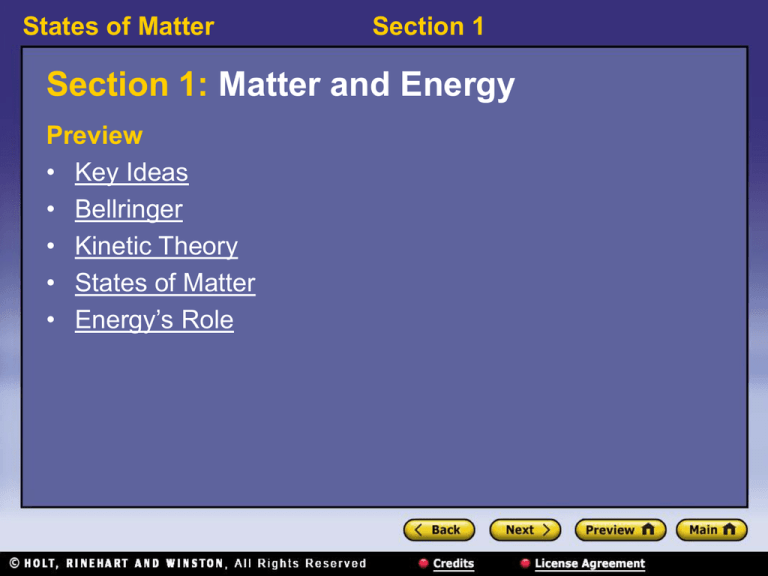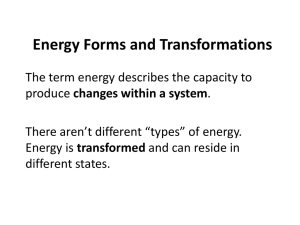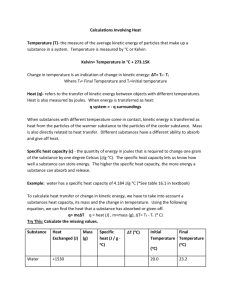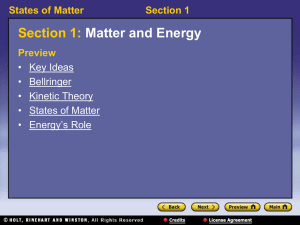Section 1: Matter and Energy States of Matter Section 1
advertisement

States of Matter Section 1 Section 1: Matter and Energy Preview • Key Ideas • Bellringer • Kinetic Theory • States of Matter • Energy’s Role States of Matter Section 1 Key Ideas 〉What makes up matter? 〉What is the difference between a solid, a liquid, and a gas? 〉What kind of energy do all particles of matter have? States of Matter Section 1 Bellringer You are already familiar with the most common states of matter: solid, liquid, and gas. For example you can see solid ice and liquid water. You cannot see water vapor, but you can feel it in the air on a humid summer day. How do you think the atoms and molecules are arranged in these different states? Examine the drawings shown below. Then answer the questions that follow. States of Matter Section 1 Bellringer, continued 1. Think about the properties of ice. Ice is somewhat hard and cannot be compressed easily. Which drawing do you think represents a solid? Explain your answer. 2. Think about the properties of gases. They are not hard and they can be compressed. Which drawing represents a gas? Explain your answer. 3. In which state(s) of matter are the particles touching? 4. In which drawing do you think the particles have the least effect on one another? Explain your answer. States of Matter Section 1 Kinetic Theory 〉What makes up matter? 〉According to the kinetic theory of matter, matter is made of atoms and molecules. These atoms and molecules act like tiny particles that are always in motion. States of Matter Section 1 Kinetic Theory, continued • The following are observations of particles in motion: – The higher the temperature of the substance is, the faster the particles move. – At the same temperature, more massive particles move slower than less massive ones. • The kinetic theory helps to explain the differences between the three common states of matter: solid, liquid, and gas. States of Matter Section 1 Visual Concept: Kinetic Molecular Theory States of Matter Section 1 States of Matter 〉What is the difference between a solid, a liquid, and a gas? 〉You can classify matter as a solid, a liquid, or a gas by determining whether the shape and volume are definite or variable. States of Matter Section 1 States of Matter, continued • Solids have a definite shape and volume. • Liquids change shape, not volume. • Gases change both shape and volume. – fluid: a nonsolid state of matter in which the atoms or molecules are free to move past each other, as in a gas or liquid • Plasma is the most common state of matter. – plasma: a state of matter that consists of free-moving ions and electrons States of Matter Section 1 Three States of Matter States of Matter Section 1 Visual Concept: Solid, Liquid, and Gas States of Matter Section 1 Energy’s Role 〉What kind of energy do all particles of matter have? 〉Because they are in motion, all particles of matter have kinetic energy. • energy: the capacity to do work States of Matter Section 1 Energy’s Role, continued • Temperature is a measure of average kinetic energy. – temperature: a measure of how hot (or cold) something is; specifically, a measure of the average kinetic energy of the particles in an object • Thermal energy depends on particle speed and number of particles. – thermal energy: the total kinetic energy of a substance’s atoms States of Matter Section 1 Kinetic Energy and States of Matter




